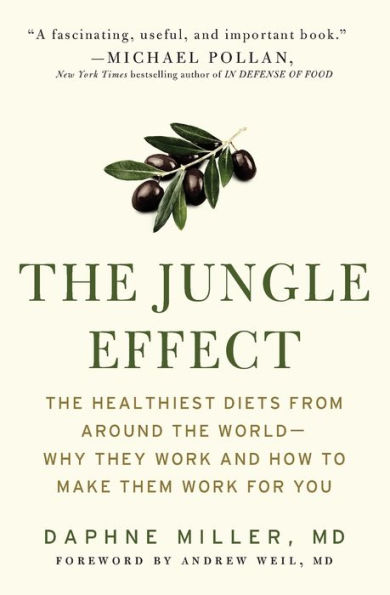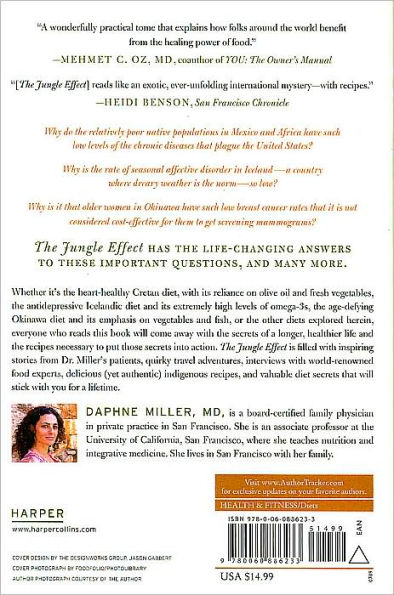Read an Excerpt
The Jungle Effect
A Doctor Discovers the Healthiest Diets from Around the World--Why They Work and How to Bring Them Home
Chapter One
Dining in the Cold Spots
Confessions of an Ill-Equipped Physician
Like Angela, most of the patients that I see daily in my medical practice are trying to prevent or treat a chronic health problem, lose weight, and preserve vitality. For many years, I felt ill equipped to help them achieve their goals. After four years of medical school, three years of residency training, and two years in a postgraduate fellowship, this is a hard confession to make.
Of course, I was well versed in using medications. Initially I found it satisfying to watch how rapidly many of these drugs took effect—sometimes lowering blood pressure, blood sugar, or cholesterol levels in a matter of days. However, after several months of practicing medicine out in the real world, it became obvious to me (and certainly obvious to my patients) that there were many unintended side effects from the treatments that I was dispensing daily with my prescription pad. Furthermore, it seemed that my standard approach was not getting at the root of so many of these health problems: the foods my patients ate on a daily basis.
These days, the majority of serious health problems that we are experiencing in the United States can be traced back to a poor diet. As a matter of fact, unhealthy eating habits, lack of exercise, and smoking are now the three leading causes of chronic disease and death in most parts of the industrialized world. It has been estimated that at least 80 percent of medical cases involving heartdisease, stroke, and type 2 diabetes and 40 percent of cancer cases could be avoided by following a healthy diet, participating regularly in physical activity, and avoiding tobacco. More troubling is the fact that these modern health problems are showing up in young people. In my practice, I have started seeing teenagers with early signs of type 2 diabetes and heart disease!
What Are Some Modern Chronic Diseases?
Modern chronic diseases are long-term health problems that are relatively rare in traditional (or indigenous) societies but increase in parallel with the degree of industrialization in a given area.
Examples include:
- Stroke
- Diabetes
- Heart disease and hypertension
- Cancer
- Emphysema
- Asthma
- Depression
- Dementia
- Gout
- Inflammatory bowel disease
- Autoimmune diseases, such as lupus and rheumatoid arthritis
Given this information it seems logical to me that the foods we eat (along with exercise and giving up tobacco) should be the first line of defense against modern chronic diseases. Food is a powerful medicine. After all, it is the medicine that most of us take willingly at least three times a day without skipping a dose. But here lies the big challenge: while most of us can agree that food is a very important therapy, how do we use it to prevent or treat chronic disease? Which foods are actually the healing ones? And, most importantly, how do we make these dietary changes in our daily lives?
In an attempt to help my patients, I set out to learn more about nutrition. I went to conferences and pursued training programs taught by internationally recognized nutritionists and physicians. Using what I learned, I started to counsel my patients on how to make dietary changes: I would launch into a discussion of healthy diets and, of course, exercise. I would rattle off the standard recommendations from groups like the American Heart Association (AHA) or the American Diabetes Association (ADA). "Decrease total daily calories to 2,000 kcal, keep daily saturated fat intake below 2 percent of calories, cholesterol intake should be no more than 150 grams per day, salt may be a factor so limit daily sodium to 2 grams daily, stick to 2 servings of refined starches. . . ."
Unfortunately, this was not the best approach. Few of us spend our days calculating our food intake in percentages and serving weights. Therefore, the general AHA or ADA recommendations have little bearing on our daily reality. Even if we are able to follow these recommendations, I am not sure how far they get us. Let me explain.
Nutrient Splitting and Wishy-Washy Nutrition Research
Much of modern nutrition science is based on the idea that there is a perfect amount of macro nutrients (proteins, carbohydrates, fats) and micro nutrients (iron, calcium, folate, etc.) that will help to preserve health or prevent a specific disease. Therefore, when counseling patients, the goal is to try to give them a prescription for how much of each of these nutrients they should consume each day. This practice of breaking nutrition down into its constituent parts is sometimes referred to (somewhat pejoratively) as "nutrient splitting."
But how do we arrive at the perfect nutrient split? How do we know the ideal amount and proportion of these recommended nutrients? Usually this is dictated by the research du jour and the latest studies to roll off the academic presses. I am sorry to report, however, that this research is often quite flawed—not through any fault of the researchers but simply because it is a near impossible task to perform a "real-life" nutrition experiment on a human.
First of all, many foods take years to have a real effect. And yet, the longest that most humans will subject themselves to a controlled laboratory rat-style food study is a couple of months. For example, let's look at the research on soy foods and breast cancer. There is evidence to suggest that adolescence may be the critical time for eating whole soy foods such as tempeh and soy beans to prevent breast cancer from developing forty-five to sixty years later. However, most of the published soy studies have focused on giving high doses of soy foods or soy extracts to mature women for several weeks to months. Given that the lag time between exposure (soy) and outcome (breast cancer) is likely to be decades, it is understandable why these studies have not netted very much useful information. In fact, some have suggested that high doses of soy this late in life might even be harmful.
The Jungle Effect
A Doctor Discovers the Healthiest Diets from Around the World--Why They Work and How to Bring Them Home. Copyright © by Daphne Miller. Reprinted by permission of HarperCollins Publishers, Inc. All rights reserved. Available now wherever books are sold.






